CARLO ANCELOTTI’S REAL MADRID
1-4-3-1-2 and the diamond midfield
TACTICS


Technology as a tool for methodology: this is the mission of YouCoach, a service designed by soccer coaches for soccer coaches. We believe in research, study and debate and work to increase the soccer culture of those who approach the coaching profession.
Thanks to our team of experts we make accessible and share quality exercises and content for all soccer levels. Since 2013 we have decided to take on the fascinating challenge of bringing to the web everything that until then was only present in print media: the content and tools that soccer coaches need to do their daily work.
Our wide range of digital products, including eBooks, videos, and collaborations with several leading professional clubs on the international scene, has made YouCoach.com a benchmark in more than 40 countries around the world for all enthusiasts who are constantly looking for new ideas and want to keep up to date with new training methodologies.
We also developed YouCoachApp, a web-based application accessible from any device and supported by a mobile app that complements the features of the web app. YouCoachApp makes it possible to simplify the work of soccer coaches and clubs, academies and college teams on and off the field, supporting them in the most common activities: collecting drills, scheduling and sharing training sessions, analyzing detailed statistics on games and players. It is the digital assistant that helps coaches save valuable time by allowing them to monitor their work at all times.
Thank you for choosing one of our products, enjoy your reading!
YouCoach Team
Keep following us on www.youcoach.com

THE AUTHORS
YouCoach staff can count on a technical team made up of coaches, athletic trainers, goalkeeper trainers, psychologists and managers who work for major and non-professional leagues. Thanks to these diverse experiences we can be familiar with different points of view and provide practical advices along with theoretical considerations, in order to share a certain way of thinking. We hope we can contribute to new soccer training methodologies development and evolution.
Our perspective includes both young and adult soccer players, in order to link technical and tactical aspects to the psychological ones, considering the athlete as a whole.
YouCoach staff is constantly evolving; thanks to the participation of our readers we can grow and spread new ideas, providing you a better service that can meet your needs on the training field.
Cross experiences, open debate and an open mind are our guiding principles, as we want to look ahead while studying present and past currents of thoughts of this beautiful sport.
6
ANCELOTTI'S REAL MADRID
CARLO
INTRODUCTION
THE TWO ANCELOTTI’S REAL MADRID CHAMPIONS LEAGUE WINNERS (2013-14 AND 2021-22)
The future seems to be bright at Real Madrid, concerning the quality of the midfield sector; Jude Bellingham has been signed, Tchouaméni, Camavinga, and Valverde are still all young, and Kroos and Modrić are still fit enough to be part of the squad even though they are the older among all the others we have just named. Carlo Ancelotti is also recognized as a “non-philosophy coach”, meaning that he hasn’t a dogmatic approach to soccer and teams’ set-up on the field. His career proves that he has changed tactics over time, attempting to balance them on the available players of the squads.
As a former Parma FC coach by the end of the 1990s, he used a flat 1-4-42, and he also became famous for refusing the inclusion of Roberto Baggio during the summer between his first and second season at Parma FC, as he didn’t think the “Codino” would have fit his system. These seasons were the only ones when he thought that the system of play came first, concerning the players. He made a sort of first step while coaching Juventus FC when Alessandro Del Piero and Zinedine Zidane couldn’t be closed into a fixed and dogmatic system of play.
When he then managed AC Milan, he went through 1-4-4-2, 1-4-3-3, and the famous “Christmas Tree” system, a 1-4-3-2-1 formation, with two mobile and technically highly gifted N.10s (Kaká and Seedorf) behind the center forward Inzaghi, and with Rui Costa and Rivaldo before them with Ševčenko. Since then, Ancelotti started to think adapting formations to players was the
7 CARLO ANCELOTTI'S REAL MADRID
CHAPTER 1
THE REVIVAL OF THE DIAMOND MIDFIELD POSSESSION
AND ATTACKING PHASES
As Carlo Ancelotti always tries to shape the teams based on the available players in the squad, the 2023-2024 Real Madrid is a different team with a different style of play and a more structured team on the field. Going in-depth with the analysis, fluidity is still a remarkable factor in Blanco’s style of play, even though Bellingham is a constant presence between the opposition’s lines and near their defensive line, furthermore along the left half-space.
The next few pictures refer to Real Madrid’s shapes in two matches against Napoli (UCL Group Stage, day 2), which will be deeply analyzed further in this book, and Sevilla (La Liga, day 10); the shapes are similar, and Jude Bellingham is always placed higher up the midfield’s teammates and beside the forwards, throughout the left half-space and final third, as average positions (pictures from 15 to 20).
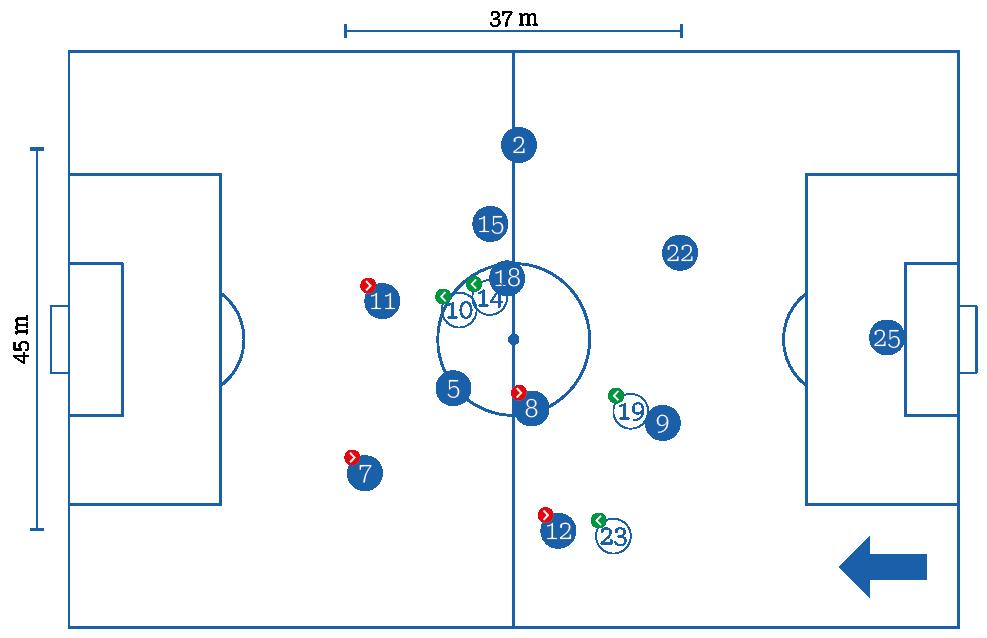
15
Picture 15 - Real Madrid’s average positions in 2023-2024 away UCL match against Napoli.
The Brazilian player is still at the top for interceptions, recoveries and clearances; analyzing the percentage of recoveries in the opposition’s half by Casemiro in the 2021-2022 season reveals his defensive contribution inside the own half, which is something that Real Madrid very missed in the big games (table 4).
From this point of view, Real Madrid is changing this season, as both Tchouaméni and Camavinga are scoring good stats in ball recoveries in the opposition’s half (42.4% and 51.4%) within their stable stats. Tchouaméni is also improving his losses percentage in the own-half (-24,08%) within 1.61 less lost ball p. 90’
The other sides of Carlo Ancelotti’s 1-4-3-1-2 revival are two basically:
1. A lack of cover along the flanks where the opponents can easily break through and create duels against the isolated full-backs on the weak side.
2. The flat formation in the center channel may create spaces for the opponents to play between the lines and directly attack the back one.
The greater part of goals that Real Madrid has conceded in ten La Liga matches and two in the Champions League group round show these two defensive deficiencies.
This first sequence shows Napoli’s attacking action that took them to the equalizing penalty in the second half of the Champions League match (pictures from 54 to 56).
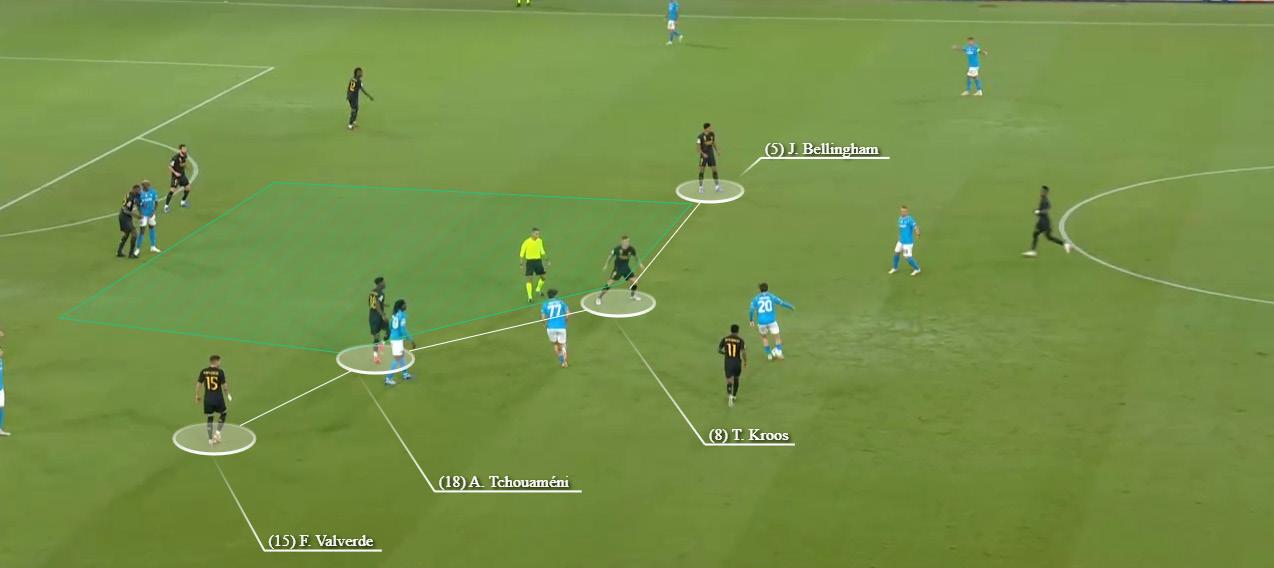
40
REAL MADRID
CARLO ANCELOTTI'S
Picture 54 - Real Madrid shaped a two-four-men line to keep the opponent away from the first third in the center channel, but they left a big gap between the lines.

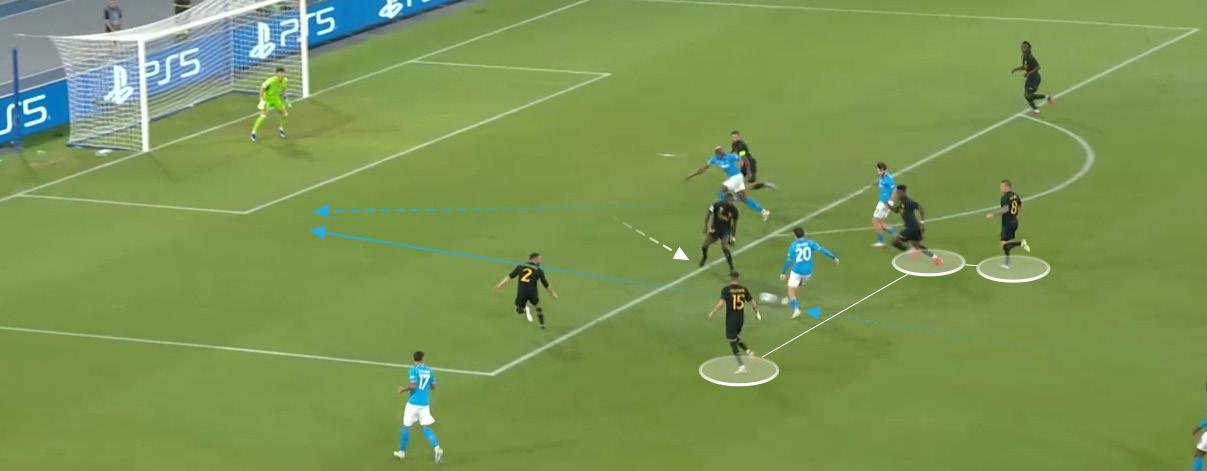
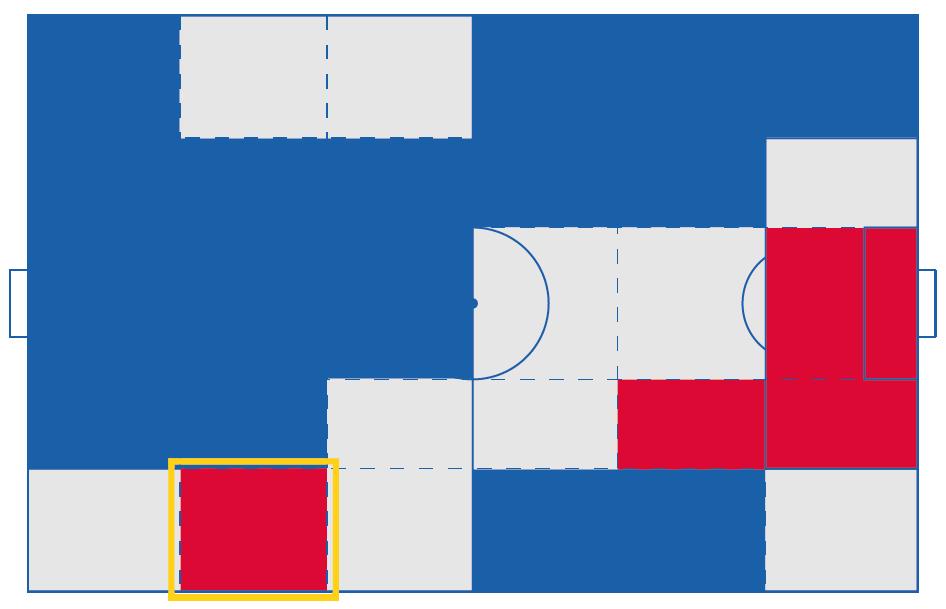
The red area on the right side of the defensive half in the territorial dominance heat map (picture 57, light blue areas are where the team gains more
41 3. DEFENSIVE PHASE TACTICAL DEFICIENCIES
Picture 55 - The opposition’s ball carrier drove the ball breaking Real Madrid’s lines, dribbling and exploiting the decoy turn of the teammate in front of him.
Picture 56 - The ball carrier drove the ball near the penalty area. Real Madrid’s right centerback attempted to counter him, but he opened a passing path toward the center forward, who beat the marker and moved off the ball in behind before suffering a penalty foul.
Picture 57 - Real Madrid’s chances conceding area (No. 6 of positional play field’s division).
REAL MADRID: SHIFTING TOWARD DIFFERENT LINES FROM A DIAMOND SHAPE IN A 6 V 6 DUEL 06
DRILL TYPE
Game-related practice
DURATION
41 minutes
PREPARATION
Playing area: 65×60 yds
Players: 12
Series: 6 of 6 minutes each with 1 minute of recovery after each round
ORGANIZATION
EQUIPMENT
• 4 poles
• 8 cones
• 12 markers
• 2 mini-goals
• 6 vests
• Balls
OBJECTIVES
• Possession
• Passing
• Receiving
• Support
• Combination play
• Mark
• Press
Prepare a playing area around the center circle and halfway line of a regular field. The center of the playing area must be around the edge between the first and the middle third of a regular field. Place a pole on each corner and four cones on each long side, as shown in the picture. In the middle of each long side place a mini-goal. Inside the bigger zone mark out a horizontal strip using markers. Two teams of six players (White attacking team and Red defending team) create a technical (buildup) and tactical (closure of passing lanes) exercise. The coach and an assistant stand outside with several balls each.
DESCRIPTION
The white team aims to overload the ball area out wide to open gaps in the center and along the opposition’s weak side. The players must be active within the areas, as in the picture: the CBs patrol the lower zone, A the middle one, B, C, and D can be active in the upper and bigger areas. From their action zones, they must be capable to invite the opposition’s pressure, without losing the needed space to pass past the defenders. The red defending team must close the passing lanes along the half line (every player must patrol their own zone), being aware of the ball’s and the potential receivers positions. The defenders must be active in the zones against the CBs (G and L) and against the three advanced opponents; they can’t press A. They create a 4-2 defensive shape.
In the picture:
• CB1 receives from the coach (1) in the right half-space
• CB1 breaks through the pressure of the opponents and passes to B, who drops back along the flank to receive (2)
84
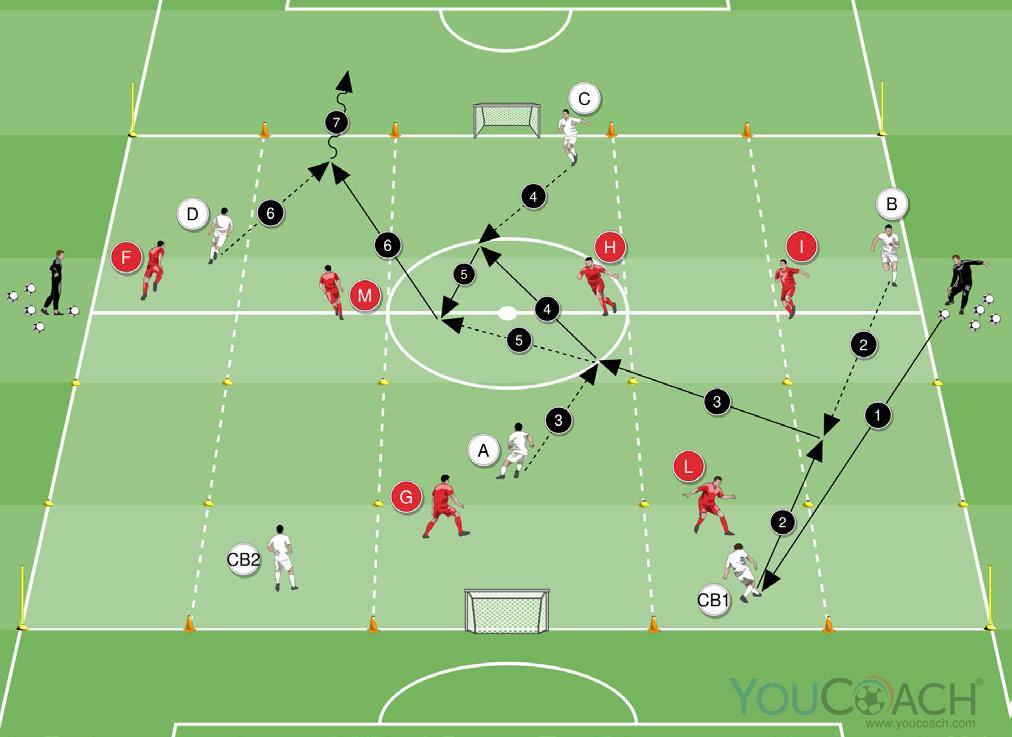
• A must exploit the space, moving forward before receiving from B in the middle (3)
• C, the upper apex of the diamond midfield, must drop back and support A to invite the pressure and open gaps along the opposite flank (A and C create a triangle passing combination 4-5)
• When A receives the return pass, D must move in behind and meet the ball on the run from A (6), before dribbling over the end-line and scoring a point (7)
If the defending team wins the possession, the exercise switches into a 6 v 6 duel to score in the mini-goal that ends only when a goal is scored, or the ball goes out of play (no zonal rules applied). If the defending team scores, it becomes the possession team in the next sequence.
RULES
• The defending team must maintain a 4-2 defensive shape
• Alternate the starting sides and teams if a goal is not scored
• The lower and upper vertexes (A and C) must create a 2 v 1 duel in the middle
• No zonal rules applied after a defending team ball’s recovery
COACHING POINTS
• Vertical play to break through the opposition’s pressure
• Move to create overloads near the ball and open gaps in the center and along the flanks in order to break the oppositions’ defense lines
• Quick combinations to beat the defenders’ actions on time
• Press the opponent with proper body orientation to counter a ball carrier and close the potential passing lanes
• Quick counter-attack after ball’s recovery
85











